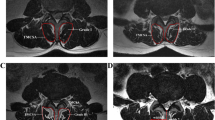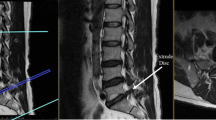Summary
We assessed in this study the potential development of postoperative muscle atrophy in the operation area in 39 patients treated by either microdiscectomy or percutaneous nucleotomy for lumbar disc herniation. The cross-sectional areas of the lumbar muscles were measured on magnetic resonance images created on the day preceding the operation and 6 months postoperatively. The cross-sections of the lumbar muscles remained unchanged during the observation period in all treated patients indicating that no muscle atrophy had developed in the operation area. Since peroperative tissue trauma may correlate with subsequent muscle denervation and atrophy, this finding may be due to the tissue sparing nature of microdiscectomy and percutaneous nucleotomy, thus encouraging the use of these techniques in the treatment of lumbar disc herniation.
Similar content being viewed by others
References
Caspar W (1977) A new surgical procedure for lumbar disc herniation causing less tissue damage through a microsurgical approach. Adv Tech Stand Neurosurg 4: 74–77
Caspar W, Campbell B, Barbier DD, Kretschmmer R, Gottfried Y (1991) The Caspar microsurgical discectomy and comparison with conventional standard lumbar disc procedure. Neurosurgery 28: 78–87
Crisco JJ, Panjabi MM (1991) The intersegmental and multisegmental muscles of the lumbar spine. A biomechanical model comparing lateral stabilizing potential. Spine 16: 793–799
Dupuis PR, Yong-Hing K, Cassidy JD, Kirkaldy-Willis WH (1985) Radiologic diagnosis of degenerative lumbar spinal instability. Spine 10: 262–276
Fairbank JCT, Couper J, Davies JB, O'Brien JP (1980) The Oswestry low back pain disability questionnaire. Physiotherapy 66: 271–273
Falck B, Nykvist F, Hurme M, Alaranta H (1993) Prognostic value of EMG in patients with lumbar disc herniation — a five year follow-up. Electromyogr Clin Neurophysiol 33: 19–26
Flicker PL, Fleckenstein JL, Ferry K, Payne J, Ward C, Mayer T, Parkey RW, Peshock RM (1993) Lumbar muscle usage in chronic low back pain. Magnetic resonance image evaluation. Spine 18: 582–586
Hijikata S (1989) Percutaneous nucleotomy. A new concept technique and 12 years' experience. Clin Orthop 238: 9–23
Kambin P, Schaffer JL (1989) Percutaneous lumbar discectomy. Review of 100 patients and current practice. Clin Orthop 238: 24–34
Kotilainen E, Alanen A, Erkintalo M, Valtonen S, Kormano M (1994) MRI changes and clinical outcome after microdiscectomy or nucleotomy for ruptured disc. Surg Neurol 41: 432–440
Kotilainen E, Valtonen S, Carlson C-Å (1993) Microsurgical treatment of lumbar disc herniation. Follow-up of 237 patients. Acta Neurochir (Wien) 120: 143–149
Kotilainen E, Valtonen S (1993) Clinical instability of the lumbar spine after microdiscectomy. Acta Neurochir (Wien) 125: 120–126
Laasonen EM (1984) Atrophy of sacrospinal muscle groups in patients with chronic, diffusely radiating lumbar back pain. Neuroradiology 26: 9–13
Lehto M, Murme M, Alaranta H, Einola S, Falck B, Järvinen M, Kalimo H, Mattila M, Paljärvi L (1989) Connective tissue changes of the multifidus muscle in patients with lumbar disc herniation. An immunohistologic study of collagen types I and III and fibronectin. Spine 14: 302–309
Macintosh JE, Bogduk N (1991) The attachments of the lumbar erector spinae. Spine 16: 783–792
Macnab I, Cuthbert H, Godfrey CM (1977) the incidence of denervation of the sacrospinales muscles following spinal surgery. Spine 2: 294–298
Mack E (1951) Electromyographic observations on the post-operative disc patients. J Neurosurg 8: 469–472
Manniche C, Skall HF, Braendholt L, Christensen BH, Christophersen L, Ellegaard B, Heilbuth A, Ingerslev M, Jorgensen OE, Larsen E, Lorentzen L, Nielsen CJ, Nielsen H, Windelin M (1993) Clinical trial of postoperative dynamic back exercises after first lumbar discectomy. Spine 18: 92–97
Manniche C, Asmussen K, Lauritsen B, Vinterberg H, Karbo H, Abildstrup S, Fischer-Nielsen K, Krebs R, Ibsen K (1933) Intensive dynamic back exercises with or without hyperextension in chronic back pain after surgery for lumbar disc protrusion. A clinical trial. Spine 18: 560–567
Mayer TG, Gatchel RJ, Kishino N, Keeley J, Capra P, Mayer H, Barnett J, Mooney V (1985) Objective assessment of spine function following industrial injury: a prospective study with comparison group and one year follow-up: 1985 Volvo Award Paper in Clinical Sciences. Spine 10: 482–493
Mayer TG, Vanharanta H, Gatchel RJ, Mooney V, Barnes D, Judge L, Smith S, Terry A (1989) comparison of CT scan muscle measurements and isokinetic trunk strength in postoperative patients. Spine 14: 33–36
Panjabi MM (1992) Dysfunction of spinal stability system and its restabilization. J Spinal Disord 5: 138–139
Parkkola R, Kormano M (1992) Lumbar disc and back muscle degeneration on MRI: Correlation to age and body mass. J Spinal Disord 5: 86–92
Parkkola R, Rytökoski U, Kormano M (1993) Magnetic resonance imaging of the discs and trunk muscles in patients with chronic low back pain and healthy control subjects. Spine 18: 830–836
Pope MH, Bevins T, Wilder DG, Frymoyer JW (1985) The relationship between anthropometric, postural, muscular, and mobility characteristics of males ages 18–55. Spine 10: 644–648
Rantanen J, Hurme M, Falck B, Alaranta H, Nykvist F, Lehto M, Einola S, Kalimo H (1993) The lumbar multifidus muscle five years after surgery for a lumbar intervertebral disc herniation. Spine 18: 568–574
SAS Institute Inc (1987) SAS/STAT guide for personal computers. Version 6 Edition, Cary, NC
Sihvonen T, Herno A, Paljärvi L, Airaksinen O, Partanen J, Tapaninaho A (1993) Local denervation atrophy of paraspinal muscles in postoperative failed back syndrome. Spine 18: 575–581
Author information
Authors and Affiliations
Rights and permissions
About this article
Cite this article
Kotilainen, E., Alanen, A., Parkkola, R. et al. Cross-sectional areas of lumbar muscles after surgical treatment of lumbar disc herniation. Acta neurochir 133, 7–12 (1995). https://doi.org/10.1007/BF01404940
Issue Date:
DOI: https://doi.org/10.1007/BF01404940




